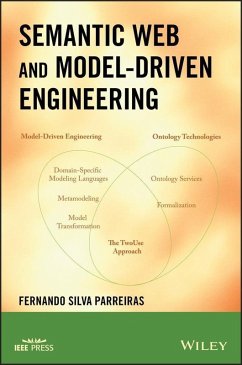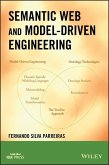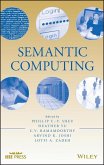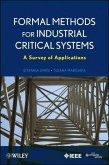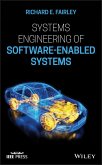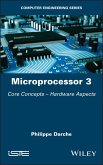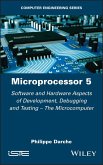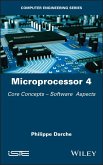Semantic Web and Model-Driven Engineering (eBook, ePUB)


Alle Infos zum eBook verschenken

Semantic Web and Model-Driven Engineering (eBook, ePUB)
- Format: ePub
- Merkliste
- Auf die Merkliste
- Bewerten Bewerten
- Teilen
- Produkt teilen
- Produkterinnerung
- Produkterinnerung

Hier können Sie sich einloggen

Bitte loggen Sie sich zunächst in Ihr Kundenkonto ein oder registrieren Sie sich bei bücher.de, um das eBook-Abo tolino select nutzen zu können.
The next enterprise computing era will rely on the synergy between both technologies: semantic web and model-driven software development (MDSD). The semantic web organizes system knowledge in conceptual domains according to its meaning. It addresses various enterprise computing needs by identifying, abstracting and rationalizing commonalities, and checking for inconsistencies across system specifications. On the other side, model-driven software development is closing the gap among business requirements, designs and executables by using domain-specific languages with custom-built syntax and…mehr
- Geräte: eReader
- mit Kopierschutz
- eBook Hilfe
- Größe: 5.34MB
![Semantic Web and Model-Driven Engineering (eBook, PDF) Semantic Web and Model-Driven Engineering (eBook, PDF)]() Fernando S. ParreirasSemantic Web and Model-Driven Engineering (eBook, PDF)69,99 €
Fernando S. ParreirasSemantic Web and Model-Driven Engineering (eBook, PDF)69,99 €![Semantic Computing (eBook, ePUB) Semantic Computing (eBook, ePUB)]() Semantic Computing (eBook, ePUB)136,99 €
Semantic Computing (eBook, ePUB)136,99 €![Formal Methods for Industrial Critical Systems (eBook, ePUB) Formal Methods for Industrial Critical Systems (eBook, ePUB)]() Stefania GnesiFormal Methods for Industrial Critical Systems (eBook, ePUB)82,99 €
Stefania GnesiFormal Methods for Industrial Critical Systems (eBook, ePUB)82,99 €![Systems Engineering of Software-Enabled Systems (eBook, ePUB) Systems Engineering of Software-Enabled Systems (eBook, ePUB)]() Richard E. FairleySystems Engineering of Software-Enabled Systems (eBook, ePUB)117,99 €
Richard E. FairleySystems Engineering of Software-Enabled Systems (eBook, ePUB)117,99 €![Microprocessor 3 (eBook, ePUB) Microprocessor 3 (eBook, ePUB)]() Philippe DarcheMicroprocessor 3 (eBook, ePUB)139,99 €
Philippe DarcheMicroprocessor 3 (eBook, ePUB)139,99 €![Microprocessor 5 (eBook, ePUB) Microprocessor 5 (eBook, ePUB)]() Philippe DarcheMicroprocessor 5 (eBook, ePUB)139,99 €
Philippe DarcheMicroprocessor 5 (eBook, ePUB)139,99 €![Microprocessor 4 (eBook, ePUB) Microprocessor 4 (eBook, ePUB)]() Philippe DarcheMicroprocessor 4 (eBook, ePUB)139,99 €
Philippe DarcheMicroprocessor 4 (eBook, ePUB)139,99 €-
-
-
Dieser Download kann aus rechtlichen Gründen nur mit Rechnungsadresse in A, B, BG, CY, CZ, D, DK, EW, E, FIN, F, GR, HR, H, IRL, I, LT, L, LR, M, NL, PL, P, R, S, SLO, SK ausgeliefert werden.
- Produktdetails
- Verlag: John Wiley & Sons
- Seitenzahl: 272
- Erscheinungstermin: 9. Mai 2012
- Englisch
- ISBN-13: 9781118135051
- Artikelnr.: 37355821
- Verlag: John Wiley & Sons
- Seitenzahl: 272
- Erscheinungstermin: 9. Mai 2012
- Englisch
- ISBN-13: 9781118135051
- Artikelnr.: 37355821
- Herstellerkennzeichnung Die Herstellerinformationen sind derzeit nicht verfügbar.
List of Tables xix
Foreword xxi
Preface xxiii
Acronyms xxvii
Part I Fundamentals
1 Introduction 3
1.1 Motivation 3
1.2 Research Questions 5
2 Model-Driven Engineering Foundations 9
2.1 Introduction 9
2.2 Model-Driven Engineering Structure 9
2.2.1 Models 11
2.2.2 Metamodels 11
2.2.3 Modeling Languages 13
2.2.4 Model Transformations 17
2.2.5 Query Languages 17
2.3 Technical Spaces 19
2.4 Conclusion 20
3 Ontology Foundations 21
3.1 Introduction 21
3.2 Ontology 22
3.2.1 Ontology Modeling 22
3.3 The Ontology Web Language 24
3.3.1 OWL 2 Syntax 24
3.3.2 OWL 2 Semantics 27
3.3.3 World Assumption and Name Assumption 27
3.4 Ontology Services 31
3.4.1 Reasoning Services 31
3.4.2 Querying 31
3.5 Ontology Engineering Services 33
3.5.1 Explanation 33
3.5.2 Ontology Matching 34
3.6 Rules 34
3.7 Metamodels for Ontology Technologies 35
3.7.1 OWL Metamodels 35
3.7.2 SPARQL Metamodel 40
3.8 Ontological Technical Spaces 41
3.9 Conclusion 43
4 Marrying Ontology and Model-Driven Engineering 44
4.1 Introduction 44
4.2 Similarities between OWL Modeling and UML Class-Based Modeling 45
4.3 Commonalities and Variations 46
4.3.1 Language 47
4.3.2 Formalism 49
4.3.3 Data Model 49
4.3.4 Reasoning 50
4.3.5 Querying 51
4.3.6 Rules 51
4.3.7 Transformation 52
4.3.8 Mediation 52
4.3.9 Modeling Level 53
4.4 The State of the Art of Integrated Approaches 54
4.4.1 Model Validation 54
4.4.2 Model Enrichment 56
4.4.3 Ontology Modeling 58
4.5 Existing Work on Classifying Integrated Approaches 58
4.6 Conclusion 59
Conclusion of Part I
Part II The TwoUse Approach
5 The TwoUse Conceptual Architecture 65
5.1 Introduction 65
5.2 Requirements for Integrating Ontology Technologies and Model-Driven
Engineering 66
5.2.1 Usage of Ontology Services in MDE 66
5.2.2 Usage of MDE Techniques in OWL Ontology Engineering 67
5.3 Addressing the Requirements with the TwoUse Approach 68
5.4 Metamodeling Architecture 70
5.4.1 The TwoUse Metamodel 70
5.5 Syntax 72
5.5.1 UML Profile for OWL 72
5.5.2 Pure UML Class Diagrams 75
5.5.3 Textual Notation 75
5.6 Conclusion 77
6 Query Languages for Integrated Models 78
6.1 Introduction 78
6.2 Combining Existing Approaches 78
6.3 Querying Ontologies Using OWL Syntax: SPARQLAS 80
6.3.1 SPARQLAS Concrete Syntax 80
6.3.2 SPARQLAS Metamodel 81
6.3.3 Transformation from SPARQLAS to SPARQL 81
6.4 Querying Integrated Models: SPARQLAS4TwoUse 82
6.5 Conclusion 84
7 The TwoUse Toolkit 86
7.1 Introduction 86
7.2 Use Case Descriptions 87
7.3 A Generic Architecture for MDE and Ontology Engineering 87
7.3.1 Core Services 88
7.3.2 Engineering Services 89
7.3.3 Front-End 90
7.4 Instantiating the Generic Model-Driven Architecture: The TwoUse Toolkit
90
7.5 Conclusion 93
Conclusion of Part II
Part III Applications in Model-Driven Engineering
8 Improving Software Design Patterns with Owl 99
8.1 Introduction 99
8.2 Case Study 100
8.2.1 Applying the Strategy Pattern 100
8.2.2 Extending to the Abstract Factory 101
8.2.3 Drawbacks 103
8.3 Application of the TwoUse Approach 104
8.3.1 OWL for Conceptual Modeling 104
8.3.2 TwoUse for Software Design Patterns: The Selector Pattern 105
8.4 Validation 109
8.4.1 Participants and Collaborations 109
8.4.2 Applicability 110
8.4.3 Drawbacks 110
8.4.4 Advantages 110
8.5 Related Work 111
8.6 Conclusion 111
9 Modeling Ontology-Based Information Systems 112
9.1 Introduction 112
9.2 Case Study 113
9.2.1 UML Class-Based Software Development 113
9.2.2 Ontology-Based Software Development 116
9.3 Application of the TwoUse Approach 117
9.3.1 Concrete Syntax 118
9.3.2 Abstract Syntax 119
9.3.3 Querying 121
9.4 Validation 121
9.4.1 Limitations 123
9.5 Conclusion 123
10 Enabling Linked Data Capabilities to MOF Compliant Models 124
10.1 Introduction 124
10.2 Case Study 125
10.2.1 Requirements 127
10.3 Application of the TwoUse Approach 128
10.3.1 Model Extension 128
10.3.2 Model Transformation 130
10.3.3 Matching 131
10.3.4 Querying with SPARQLAS 131
10.4 Validation 132
10.4.1 Limitations 134
10.5 Related Work 134
10.6 Conclusion 135
Conclusion of Part III
Part IV Applications in the Semantic Web
11 Model-Driven Specification of Ontology Translations 141
11.1 Introduction 141
11.2 Case Study 142
11.3 Application of the TwoUse Approach 145
11.3.1 Concrete Syntax 145
11.3.2 Metamodels 146
11.3.3 Model Libraries 148
11.3.4 Semantics 148
11.3.5 Ontology Translation Process 148
11.3.6 Implementation 149
11.4 Examples 150
11.5 Analysis 153
11.6 Related Work 154
11.7 Conclusion 155
12 Automatic Generation of OntologyAPIs156
12.1 Introduction 156
12.2 Case Study 158
12.3 Application of the TwoUse Approach 161
12.3.1 Key Domain Concepts 161
12.3.2 agogo Concrete Syntax by Example 163
12.3.3 Implementation 166
12.4 Analysis 167
12.5 Related Work 169
12.6 Conclusion 170
13 Using Templates in Owl Ontologies 171
13.1 Introduction 171
13.2 Case Study 172
13.3 Application of the TwoUse Approach 174
13.3.1 Extending the OWL Metamodel with Templates 174
13.3.2 Semantics of Templates 177
13.3.3 Notations for Templates in OWL 179
13.3.4 Query Templates 180
13.4 Analysis 181
13.4.1 Limitations 182
13.5 Related Work 182
13.6 Conclusion 183
Conclusion of Part IV
14 Conclusion 187
14.1 Contributions 187
14.2 Outlook 189
14.2.1 Ongoing Research 189
Appendix A 191
A.1 EBNF Defi nition of the Concrete Textual Syntax for TwoUse 191
A.2 EBNF Grammar of SPARQLAS Functional Syntax 192
A.3 EBNF Grammar of SPARQLAS Manchester Syntax 197
A.4 SPARQLAS Metamodel 202
A.5 Ecore to OWL: Translation Rules 204
Appendix B206
B.1 Use Cases 206
B.1.1 Design Integrated Models 206
B.1.2 Design Integrated UML Class Diagram 206
B.1.3 Design Integrated Ecore Model 207
B.1.4 Specify SPARQLAS4TwoUse Query Operations 207
B.1.5 Transform to OWL 207
B.1.6 Compute Alignments 208
B.1.7 Browse 208
B.1.8 Explain Axioms 209
B.1.9 Query UML Class-Based Models 209
B.1.10 Query OWL Ontologies 209
B.1.11 Design Ontology Engineering Services 209
B.1.12 Design Ontology API 210
B.1.13 Design Ontology Translation 210
B.1.14 Design Ontology Template 210
B.1.15 Generate Service 211
B.2 Connecting Use Cases with Requirements 211
References 212
Index 226
List of Tables xix
Foreword xxi
Preface xxiii
Acronyms xxvii
Part I Fundamentals
1 Introduction 3
1.1 Motivation 3
1.2 Research Questions 5
2 Model-Driven Engineering Foundations 9
2.1 Introduction 9
2.2 Model-Driven Engineering Structure 9
2.2.1 Models 11
2.2.2 Metamodels 11
2.2.3 Modeling Languages 13
2.2.4 Model Transformations 17
2.2.5 Query Languages 17
2.3 Technical Spaces 19
2.4 Conclusion 20
3 Ontology Foundations 21
3.1 Introduction 21
3.2 Ontology 22
3.2.1 Ontology Modeling 22
3.3 The Ontology Web Language 24
3.3.1 OWL 2 Syntax 24
3.3.2 OWL 2 Semantics 27
3.3.3 World Assumption and Name Assumption 27
3.4 Ontology Services 31
3.4.1 Reasoning Services 31
3.4.2 Querying 31
3.5 Ontology Engineering Services 33
3.5.1 Explanation 33
3.5.2 Ontology Matching 34
3.6 Rules 34
3.7 Metamodels for Ontology Technologies 35
3.7.1 OWL Metamodels 35
3.7.2 SPARQL Metamodel 40
3.8 Ontological Technical Spaces 41
3.9 Conclusion 43
4 Marrying Ontology and Model-Driven Engineering 44
4.1 Introduction 44
4.2 Similarities between OWL Modeling and UML Class-Based Modeling 45
4.3 Commonalities and Variations 46
4.3.1 Language 47
4.3.2 Formalism 49
4.3.3 Data Model 49
4.3.4 Reasoning 50
4.3.5 Querying 51
4.3.6 Rules 51
4.3.7 Transformation 52
4.3.8 Mediation 52
4.3.9 Modeling Level 53
4.4 The State of the Art of Integrated Approaches 54
4.4.1 Model Validation 54
4.4.2 Model Enrichment 56
4.4.3 Ontology Modeling 58
4.5 Existing Work on Classifying Integrated Approaches 58
4.6 Conclusion 59
Conclusion of Part I
Part II The TwoUse Approach
5 The TwoUse Conceptual Architecture 65
5.1 Introduction 65
5.2 Requirements for Integrating Ontology Technologies and Model-Driven
Engineering 66
5.2.1 Usage of Ontology Services in MDE 66
5.2.2 Usage of MDE Techniques in OWL Ontology Engineering 67
5.3 Addressing the Requirements with the TwoUse Approach 68
5.4 Metamodeling Architecture 70
5.4.1 The TwoUse Metamodel 70
5.5 Syntax 72
5.5.1 UML Profile for OWL 72
5.5.2 Pure UML Class Diagrams 75
5.5.3 Textual Notation 75
5.6 Conclusion 77
6 Query Languages for Integrated Models 78
6.1 Introduction 78
6.2 Combining Existing Approaches 78
6.3 Querying Ontologies Using OWL Syntax: SPARQLAS 80
6.3.1 SPARQLAS Concrete Syntax 80
6.3.2 SPARQLAS Metamodel 81
6.3.3 Transformation from SPARQLAS to SPARQL 81
6.4 Querying Integrated Models: SPARQLAS4TwoUse 82
6.5 Conclusion 84
7 The TwoUse Toolkit 86
7.1 Introduction 86
7.2 Use Case Descriptions 87
7.3 A Generic Architecture for MDE and Ontology Engineering 87
7.3.1 Core Services 88
7.3.2 Engineering Services 89
7.3.3 Front-End 90
7.4 Instantiating the Generic Model-Driven Architecture: The TwoUse Toolkit
90
7.5 Conclusion 93
Conclusion of Part II
Part III Applications in Model-Driven Engineering
8 Improving Software Design Patterns with Owl 99
8.1 Introduction 99
8.2 Case Study 100
8.2.1 Applying the Strategy Pattern 100
8.2.2 Extending to the Abstract Factory 101
8.2.3 Drawbacks 103
8.3 Application of the TwoUse Approach 104
8.3.1 OWL for Conceptual Modeling 104
8.3.2 TwoUse for Software Design Patterns: The Selector Pattern 105
8.4 Validation 109
8.4.1 Participants and Collaborations 109
8.4.2 Applicability 110
8.4.3 Drawbacks 110
8.4.4 Advantages 110
8.5 Related Work 111
8.6 Conclusion 111
9 Modeling Ontology-Based Information Systems 112
9.1 Introduction 112
9.2 Case Study 113
9.2.1 UML Class-Based Software Development 113
9.2.2 Ontology-Based Software Development 116
9.3 Application of the TwoUse Approach 117
9.3.1 Concrete Syntax 118
9.3.2 Abstract Syntax 119
9.3.3 Querying 121
9.4 Validation 121
9.4.1 Limitations 123
9.5 Conclusion 123
10 Enabling Linked Data Capabilities to MOF Compliant Models 124
10.1 Introduction 124
10.2 Case Study 125
10.2.1 Requirements 127
10.3 Application of the TwoUse Approach 128
10.3.1 Model Extension 128
10.3.2 Model Transformation 130
10.3.3 Matching 131
10.3.4 Querying with SPARQLAS 131
10.4 Validation 132
10.4.1 Limitations 134
10.5 Related Work 134
10.6 Conclusion 135
Conclusion of Part III
Part IV Applications in the Semantic Web
11 Model-Driven Specification of Ontology Translations 141
11.1 Introduction 141
11.2 Case Study 142
11.3 Application of the TwoUse Approach 145
11.3.1 Concrete Syntax 145
11.3.2 Metamodels 146
11.3.3 Model Libraries 148
11.3.4 Semantics 148
11.3.5 Ontology Translation Process 148
11.3.6 Implementation 149
11.4 Examples 150
11.5 Analysis 153
11.6 Related Work 154
11.7 Conclusion 155
12 Automatic Generation of OntologyAPIs156
12.1 Introduction 156
12.2 Case Study 158
12.3 Application of the TwoUse Approach 161
12.3.1 Key Domain Concepts 161
12.3.2 agogo Concrete Syntax by Example 163
12.3.3 Implementation 166
12.4 Analysis 167
12.5 Related Work 169
12.6 Conclusion 170
13 Using Templates in Owl Ontologies 171
13.1 Introduction 171
13.2 Case Study 172
13.3 Application of the TwoUse Approach 174
13.3.1 Extending the OWL Metamodel with Templates 174
13.3.2 Semantics of Templates 177
13.3.3 Notations for Templates in OWL 179
13.3.4 Query Templates 180
13.4 Analysis 181
13.4.1 Limitations 182
13.5 Related Work 182
13.6 Conclusion 183
Conclusion of Part IV
14 Conclusion 187
14.1 Contributions 187
14.2 Outlook 189
14.2.1 Ongoing Research 189
Appendix A 191
A.1 EBNF Defi nition of the Concrete Textual Syntax for TwoUse 191
A.2 EBNF Grammar of SPARQLAS Functional Syntax 192
A.3 EBNF Grammar of SPARQLAS Manchester Syntax 197
A.4 SPARQLAS Metamodel 202
A.5 Ecore to OWL: Translation Rules 204
Appendix B206
B.1 Use Cases 206
B.1.1 Design Integrated Models 206
B.1.2 Design Integrated UML Class Diagram 206
B.1.3 Design Integrated Ecore Model 207
B.1.4 Specify SPARQLAS4TwoUse Query Operations 207
B.1.5 Transform to OWL 207
B.1.6 Compute Alignments 208
B.1.7 Browse 208
B.1.8 Explain Axioms 209
B.1.9 Query UML Class-Based Models 209
B.1.10 Query OWL Ontologies 209
B.1.11 Design Ontology Engineering Services 209
B.1.12 Design Ontology API 210
B.1.13 Design Ontology Translation 210
B.1.14 Design Ontology Template 210
B.1.15 Generate Service 211
B.2 Connecting Use Cases with Requirements 211
References 212
Index 226
